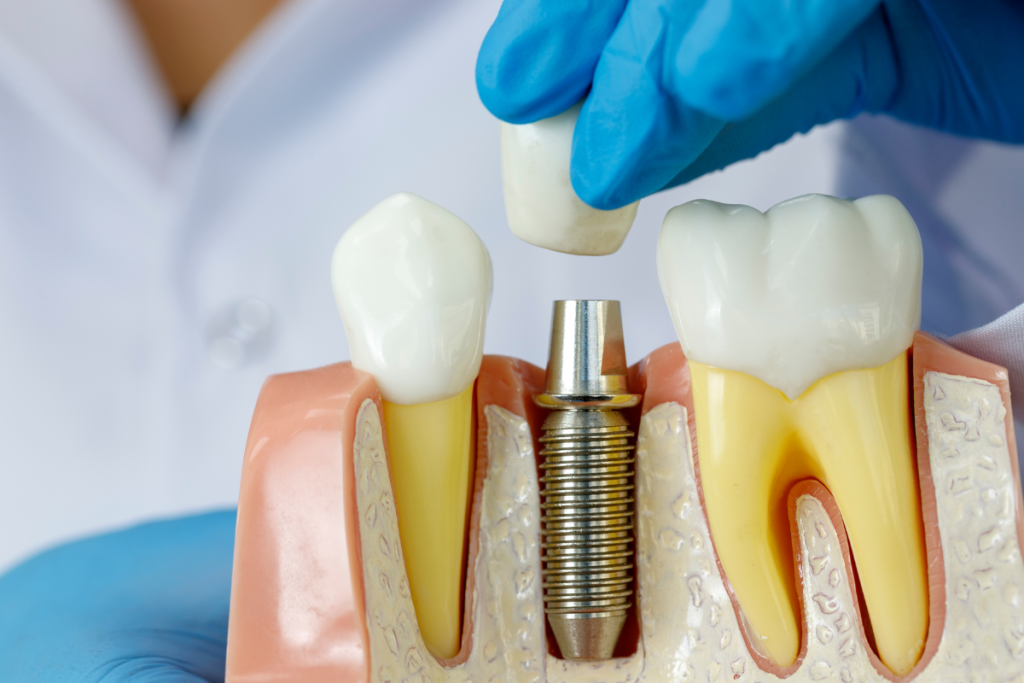No one likes to think about losing a tooth, but it happens to many people. If you’re one of the unlucky ones and need a dental implant, don’t worry – you’re in good company.
Dental implants are a popular tooth-replacement option, but they can be confusing to understand. If you’re considering dental implants, read on to learn everything you need to know about them!
In this blog post, we’ll cover what dental implants are, the different types, their benefits and risks, and the entire dental implant process. By the end of this post, you’ll have all the information you need to make an informed decision about whether or not dental implants are right for you.
What Are Dental Implants?

Dental implants are artificial replacement teeth placed in the jawbone to support a dental prosthesis, such as a crown, bridge, or denture.
A dental implant is a small titanium post that is inserted into the jawbone to serve as a replacement for the root of a natural tooth. This artificial tooth root will fuse with the natural bone over time. This process, called osseointegration, provides a strong and stable foundation for the dental prosthesis.
Dental implants are an alternative to dentures, getting rid of annoying denture glues. They effectively address tooth loss and can improve the function and appearance of your smile. These implants look and feel very natural, allowing people to eat and speak confidently.
Different Types of Dental Implants
Single Tooth Implant
Multi-Tooth Implant (Implant-Supported Bridge)
Implant-Retained Dentures
Reasons You May Consider Getting Dental Implants
When most people think of dental implants, they think of the cosmetic benefits. And it’s true that dental implants can give you a beautiful, natural-looking smile.
However, dental implants offer much more than just aesthetic value. They can also improve your oral health, eating and speaking ability, and overall quality of life.
The following are the benefits one can get from dental implants:
Dental implants are the closest thing to natural teeth.
Dental implants prevent bone loss.
Dental implants are easy to maintain.
How to Prepare for Dental Implants

Dental implant surgery involves placing a metal post in the jawbone, which acts as a root for the new tooth. To prepare for dental implants, having healthy gums and adequate bone structure is important.
Here’s what you can do to prepare for dental implants:
- The first step is to schedule a consultation with a dentist. During the consultation, the dentist will evaluate your mouth and determine if dental implants are right for you.
- If you decide to proceed with the surgery, the next step is to have a thorough dental examination. This will help determine the health of your gums and jawbone, as well as the location of your nerves and sinuses. Dental scans or x-rays will be taken. This will provide a detailed map of your mouth, which the dentist will use to plan the placement of the implants.
- Once all of this information has been gathered, your implant dentist will be able to develop a customized dental treatment plan just for you.
The Procedure for Getting Dental Implants
Step 1: Damaged tooth removal
Step 2: Jawbone preparation, Grafting when needed
Often, patients undergoing implant surgery have thin or weak jawbones.
A bone graft, which increases the amount of bone, ensures success. Bone graft options include synthetic bone substitutes or natural grafts, in which bone is taken from another part of the patient’s body.
A dental implant can only be placed after bone grafts have healed for several months. Fortunately, bone grafts aren’t necessary in every case.
Step 3: Dental implant placement
The dentist cuts the gums with small instruments to expose the bone during the actual procedure. Holes are drilled in the bone and an implant is placed deep into the bone.
If a front tooth is being restored, a temporary removable solution will be placed in the hole while the implant heals below the gum line. The dentist will not put anything over a back tooth.
Step 4: Bone Healing and Growth
Step 5: Abutment placement
Step 6: Artificial tooth placement
A new impression of your mouth will be taken once the implant has grown into the bone and become strong enough to support chewing.
Once the dental technician has created the crown in a lab, it will be applied to the tooth. Artificial crowns resemble natural teeth. The crown is the only part of the implant that is visible since it sits on the abutment (connector).
What to Expect After a Dental Implant Procedure
First 24 Hours Post-Surgery
For the first 24 hours, it’s normal to experience some bleeding, swelling and bruising around the implant site. You may also have some discomfort and pain, which can be managed with over-the-counter medication or a prescription from your dentist.
It’s important to take it easy during this time and avoid exerting yourself. You should also avoid eating hard or crunchy foods as they irritate the implant site. Stick to softer foods like soup, pudding, and mashed potatoes.
More Than 24 Hours Post-Surgery
After the initial 24 hours, the swelling and bruising will start to go down. The pain may also start to lessen, but it’s still important to take it easy. Slowly introduce solid foods back into your diet, being careful not to bite down too hard on the implant site. Avoid contact sports and other activities that could put undue pressure on the implants.
You should start seeing your dentist for regular checkups and cleanings starting about six weeks after the implant surgery. These follow-up appointments will help ensure that the implants are healing properly. Be sure to brush and floss regularly at home to keep your teeth and gums healthy.
How Long Does It Take for Dental Implants to Heal?
One of the main concerns about dental implants is the healing time required before the implant can support a dental prosthetic.
The good news is that dental implants typically heal within 3-6 months. The first stage of healing, known as osseointegration, occurs when the implant fuses with the jawbone. This entire process can take anywhere from 4-12 weeks.
Once osseointegration is complete, the implant can support a dental prosthetic. In some cases, dental implants can be loaded immediately after surgery. However, this is only possible if there is enough bone density to support the dental prosthetic.
In most cases, it is recommended to wait 3-6 months before loading an implant. This gives the implant time to fuse with the jawbone and fully integrate.
Recovery times vary from person to person. But while dental implants have a lengthy healing time, patients who are willing to wait for their dental implants to heal can enjoy many years of eating, speaking, and smiling with confidence.
What Happens If I Do Not Have Sufficient Bone?
One of the most important requirements for successful dental implants is sufficient bone. The implant must be able to fuse with the bone to provide a strong and stable foundation for the new tooth.
However, bone loss is a common side effect of tooth loss, and it can sometimes leave patients with insufficient bone for an implant. In these cases, there are a few options available, such as:
Bone Grafting
Bone Substitutes
Sinus Lift
A sinus lift procedure can often add enough bone to the upper jaw to support an implant. This involves lifting the sinus membrane and adding bone to the area. This option is typically used in cases where the back of the upper jaw has been eroded.
If you are considering dental implants but have concerns about insufficient bone, speak to your dentist. They will be able to assess your situation and recommend the best course of treatment among all other treatment options.
Can Anyone Get Dental Implants?

Unfortunately, not everyone can get dental implants. The ideal candidate for dental implants is someone who:
- Has no gum disease, has healthy gums and enough bone density to support the implant.
- Is committed to maintaining good oral hygiene, as implants require special care.
- Is in generally good health, as certain medical conditions can complicate the implant process.
- Is prepared for a lengthy procedure.
Patients not considered suitable for dental implants include those who smoke, have diabetes, or suffer from periodontal disease.
What Is the Lifespan of Dental Implants?
Dental implants are very strong and durable and can last for many years with proper care. In fact, the lifespan of dental implants is usually 10-15 years or more.
However, it is important to keep in mind that everyone is different, and some people may experience problems with their implants sooner than others.
Factors such as smoking and poor oral hygiene can affect the lifespan of dental implants. Dental implants can provide you with a long-lasting, beautiful smile with proper care and maintenance.
How Do Dental Implants Maintain Your Oral Health?
Prevent dental instability
Preserve healthy bone tissue
Prevent tooth decay
Promote proper chewing
How Painful Is Getting a Dental Implant?
It’s natural to be apprehensive about getting any kind of surgery, and dental implants are no exception. However, there is no one-size-fits-all answer to this question, as pain tolerance varies from person to person.
Most people report feeling only minimal discomfort during the procedure. The pain is typically caused by the placement of the titanium screw into the jawbone. This can be alleviated with local anesthesia, which numbs the area around your implant.
Once the implant is in place, patients typically feel only minor soreness or tenderness for a few days, but this can be easily relieved with over-the-counter pain medication.
Overall, most patients find that getting a dental implant is much less painful than anticipated.
Possible Risks with Dental Implants
In most cases, dental implants are a success.
There are, however, rare cases when implants do not heal properly. Smoking, for instance, is associated with implant failures. To reduce this risk, practising good oral health care at home is important, including brushing, flossing, and eating the right foods.
Minor discomfort is normal following dental surgery. The following conditions are common (but not dangerous):
- Skin or gums bruising
- Swelling on the face and gum
- Minor bleeding
- Pain at the implant site
There are more serious risks that can develop after implant placement, including:
- Damage to nearby teeth, blood vessels, and gums
- Infection at the implant site
- Issues with your sinuses and pressure (if your implant is placed in your upper jaw)
- Jaw pain and a fractured jaw
- Tingling in the mouth and lips can be a result of nerve damage
What Can I Eat After Dental Implant Surgery?

After dental implant surgery, it is important to take care of your mouth as it heals. This includes eating the right foods. So, what can you eat after dental implant surgery?
In the first 24 hours after surgery, it is important to eat soft foods that are easy to chew. This will help reduce swelling and pain. Avoid foods that are hard, crunchy, and spicy. Avoid alcohol, carbonated drinks, and hot beverages, as well.
You can try eating the following:
- Mashed potatoes
- Soups
- Yogurt
- Eggs
- Oatmeal
After the first 24 hours, you can gradually resume your normal diet. However, it is still important to avoid hard or crunchy foods. These can damage your dental implants. Stick to:
- Soft fruits
- Cooked vegetables
- Soft cheeses
- Tender meat
- Fish
How Much Do Dental Implants Cost?
Dental implants can be a significant investment, and it is important to understand the cost before undergoing dental implant treatment.
The cost of dental implants in Australia varies depending on a number of factors, including the type of implant you choose, the number of implants you need, the complexity of your case, and your dentist’s location.
Treatment costs of dental implants are usually broken down into three main categories: the implant itself, the dental implant abutment which connects the implant to the artificial tooth, and the artificial tooth.
Dental implants have a price range of $3,000 to $6,000 per implant. However, more complex cases can cost more than $10,000 per tooth. Additionally, you will need to factor in the cost of any associated dental work.
In some cases, dental insurance may cover part of the cost of dental implants, but it is important to check with your insurer beforehand.
Final Thoughts
Dental implants can help address tooth loss and improve your smile’s function and aesthetic appearance. If you’re considering dental implants, Mundaring Dental Centre is here to help.
We offer various implant options that will meet your needs and budget. Our friendly team of experienced dental professionals will ensure you receive the best possible care before, during, and after your procedure.
Please book an appointment online or call us today at (08) 6495 2000 to learn more about dental implants and how they can benefit you.
ACHIEVE A BEAUTIFUL SMILE WITH DENTAL IMPLANTS
Do you have one or more missing teeth? Are you looking for a treatment for your broken and decayed teeth? If you answered yes, visit our dental clinic to have high-quality dental implants.
 By Dr. Rahul Pankhaniya
By Dr. Rahul Pankhaniya 
